Finally! April the Giraffe Delivers Her Newborn

After keeping millions of people anxiously glued to their computer and phone screens on "belly watch" since Feb. 11, April the pregnant giraffe delivered her calf at Animal Adventure Park (AAP) in Harpursville, New York, on April 15.
The 15-year-old mother welcomed her newborn at 9:54 a.m. local time. This is April's fourth calf, the first to be conceived by her mate, 5-year-old Oliver, and the first baby giraffe born at AAP. (The announcement of the calf's gender will be made after its birth by a text alert system, according to the park.)
Barely into its first day of life, April's calf is already a YouTube sensation, with more than 561,000 YouTube viewers checking in to coo over the gangly baby at 11:24 a.m. The young giraffe will stick close to April and will be kept apart from its father until it is weaned, which can take about 6 to 10 months, AAP officials explained in a description for the live video feed streaming from April's indoor pen. [Watch April the Giraffe with Baby]
Here's how the birth went down this morning:
9:48 a.m.: The head appears. 9:53 a.m.: The baby's head, neck and shoulders are visible. 9:54 a.m.: The baby begins to slide from April's vulva and lands on the ground, a six-foot drop! April begins to clean the new arrival. 9:56 a.m.: The calf lifts its head and begins to look around. 10:07 a.m.: Jordan Patch, Animal Adventure Park (AAP) owner, ended the AAP Facebook Live transmission, saying: "We're gonna let mom and baby do their thing for a little bit." He said that the birth went perfectly, and that the baby was already nibbling at April, looking to nurse. "As soon as we know the gender, we'll let everybody know," Patch added.
As of 11:30 a.m., the calf was slowly walking around the enclosure, wobbly legs and all, with proud mama April continuing to give him or her a little saliva bath.
For weeks, April commanded a captivated internet audience as she ambled around her pen, her protruding belly showing ripples of activity when the fetus moved inside. During the week of March 13, some signs of impending birth became more pronounced, with "significant changes" visible, her caregivers reported on Facebook.
Sign up for the Live Science daily newsletter now
Get the world’s most fascinating discoveries delivered straight to your inbox.
"Her back end has become significantly larger and relaxed, motion and pulsing in this area has been noted, and discharge has been observed," they wrote. However, April was not yet experiencing active labor, they explained.
On March 14, as winter storm Stella pounded the northeastern U.S., caregivers stayed overnight at the zoo to keep watch on their charges. April's behavior during the early morning hours prompted them to check in on her, but her condition remained unchanged from the prior evening, according to a keeper's report.
A female giraffe carries her fetus for 15 months, which might seem like a long time when compared to a human mother's 9-month pregnancy. But other mammals carry their young for even longer. Gestation lasts for up to 16 months in sperm whales and up to 18 months in killer whales, according to the National Oceanic and Atmospheric Administration (NOAA). And African elephants, the largest land animals alive today, gestate longer than any other mammal — 22 months, according to the World Wildlife Fund. [Infographic: For How Long Are Animals Pregnant?]
Original article on Live Science.

Mindy Weisberger is an editor at Scholastic and a former Live Science channel editor and senior writer. She has reported on general science, covering climate change, paleontology, biology and space. Mindy studied film at Columbia University; prior to Live Science she produced, wrote and directed media for the American Museum of Natural History in New York City. Her videos about dinosaurs, astrophysics, biodiversity and evolution appear in museums and science centers worldwide, earning awards such as the CINE Golden Eagle and the Communicator Award of Excellence. Her writing has also appeared in Scientific American, The Washington Post and How It Works Magazine. Her book "Rise of the Zombie Bugs: The Surprising Science of Parasitic Mind Control" will be published in spring 2025 by Johns Hopkins University Press.










